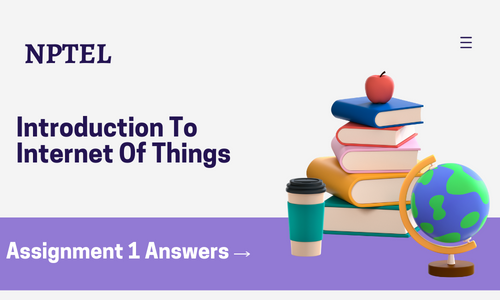Hello learners In this article we are going to discuss NPTEL Introduction To Internet Of Things Assignment 1 Answers. All the Answers provided below to help the students as a reference, You must submit your assignment with your own knowledge and use this article as reference only.
About the course:-
Internet of Things (IoT) is presently a hot technology worldwide. Government, academia, and industry are involved in different aspects of research, implementation, and business with IoT. IoT cuts across different application domain verticals ranging from civilian to defence sectors. These domains include agriculture, space, healthcare, manufacturing, construction, water, and mining, which are presently transitioning their legacy infrastructure to support IoT.
NPTEL Introduction To Internet Of Things Assignment 1 Answers 2024:
1. What is the full form of IoT?
a. Internet of Tasks
b. Internet of Things
c. Internet of Tasks
d. None of these
Answer :- b
2. Which of the following technologies have unified and has resulted in the evolution of IoT?
a. Low-power embedded systems
b. Cloud Computing
¢. Machine Learning
d. All of these
Answer :- d
3. Which of the following are the enablers of IoT?
a. RFID
b. Nanotechnology
c. Sensors
d. All of these
Answer :- d
4. Which of the following is/are a function of an IoT Gateway?
a. Connects the IoT LAN to a WAN
b. Can implement several LAN and WAN
c. Forwards packets between LAN and WAN on the IP layer
d. All of these
Answer :- d
5. State whether the following statement is True or False.
Statement: “The same address of an IoT device may be repeated in the domain of another
gateway. The gateway has a unique network prefix, which can be used to identify them
globally.”
a. True
b. False
Answer :- a
6. In a node/network is connected to multiple networks for improved
reliability.
a. Transparent roaming
b. Multi-homing
c. None of these
d. Both (a) and (b)
Answer :- b
7. The IPv4 notation uses number of bits to represent an address.
a. 33
b. 32
c. Both (a) and (b)
d. None of these
Answer :- b
8. The “Source Address” field in the IPv6 header is of bits in length.
a. 32
b. 64
c. 128
d. None of these
Answer :- c
9. A device which detects or measures a physical property and records, indicates, or otherwise
responds to it is called ?
a. A sensor
b. An actuator
c. A Transducer
d. A processor
Answer :- a
10. A microphone is an example of an .
a. Input device and actuator
b. Only actuator
c. Only Transducer
d. Input device and transducer
Answer :- d
11. State whether the following statement 1s True or False.
Statement: A sensor is only sensitive to the measured property for which it has been made
(e.g.. A temperature sensor senses the ambient temperature of a room.)
a. True
b. False
Answer :- a
12. Based on the data type, sensors are classified as .
a. Only scalar
b. Only vector
¢. Scalar and Vector/Multimedia
d. None of these
Answer :- c
13. State whether the following statement is True or False.
Statement: The more is the resolution of a sensor, the less accurate it its precision.
a. True
b. False
Answer :- a
14. The sensitivity of a sensor under real conditions may differ from the value specified. This is called
a. Physical error
b. Sensitivity error
¢. Rounding error
d. None of these
Answer :- b
15. A sensor node is made up of which of the following?
a. Sensor/Sensing units
b. A processing unit
c. A power unit
d. All of these
Answer :- d

